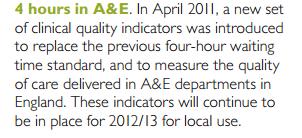How long are A&E waiting times?
Andrew Lansley: "96% of patients are waiting less than four hours in accident and emergency departments."
Andy Burnham: "The statistics [Mr Lansley] just reeled off do not include people who give up waiting in A and E..."
Andrew Lansley: "Under the Labour Government, no one ever measured whether patients left A and E without being seen. For the first time, we are measuring that, and we publish the results in the A and E quality indicators. There was a variation between about 0.5% and 11% of patients leaving without being seen when we first published that, but since then the variation has reduced. The average number has gone down, and it is now at 3%..."
House of Commons, 4 July 2012
Health Secretary Andrew Lansley found himself under fire earlier this week from his shadow Andy Burnham after he claimed that 96 per cent of NHS patients wait less than four hours for treatment in A&E.
Mr Burnham argued that this figure did not take into account those who gave up waiting before they had a chance to be seen by medical staff.
The Shadow Health Secretary suggested that these figures might therefore mask wider problems in A&E wards. So do we have the full picture on NHS A&E efficiency?
Analysis
Mr Lansley's original claim references his Department's annual NHS Report, published earlier this week.
Looking through it, it is easy to pick out the source of his figures. According to the Report, 96.6 per cent of patients are seen within four hours, more than the target set at 95 per cent:

The NHS annual report in turn sources these statistics from another set of Departmental official figures: Accident and Emergency Quarterly Monitoring Data Set (QMEA), which date back to November 2011.
As we can see from the table below, depending on whether you look at major A&E departments or Minor Injury Units and Walk in Clinics, the percentage of patients who spent less than 4 hours in A&E is either 95.9 or 97.3 per cent, the average of which is the 96.6 per cent quoted by Mr Lansley.

But do these figures include patients who leave A&E prior to being seen by a professional?
The DH data defines the waiting time as the total time spent in A&E from arrival to when the patient leaves A&E, either on admission, transfer to another agency or organisation or discharge.
According to the guidance that accompanies the data, 'discharge' can also include those patients that leave A&E of their own volition before they get the chance to be seen:
"patients who leave A&E before being treated the discharge time should be recorded as the time when it is found that the patient is no longer in the department."
Mr Burnham might therefore have a point, as not all of the patients that fall into the 96 per cent quoted by Mr Lansley have necessarily been seen at all.
The Health Secretary claims that his Department is now taking steps to tackle this gap in the data, and if we return to the NHS annual report we can get a sense of what he means. It states:

These changes are outlined in full in the Revised Operating Framework for NHS in England 2010-11, which was published in June 2011.
This document suggests a number of new measures to supplement overall waiting time data, such as the time until a clinician initially assesses a patient, the time until treatment of the patient, and the rate at which patients leave A&E without being seen. These clinical quality indicators came into effect from April 2011.
Mr Lansley claims that the percentage of patients leaving without being seen is 3 per cent.
According to the latest statistics from February 2012, published at the end of June, around 2.8 percent of patients left A&E across England without being seen, backing the Health Secretary up.
We should be careful about drawing too many conclusions from these figures however. The NHS Information Centre has released them as 'experimental statistics', and warns that "data quality and completeness is generally poor."
Specifically, the data does not record figures from all NHS Trusts and is still a work in progress. The last published report, which covered the period from April 2010 to March 2011, record that 3.4% of attendances left A&E without being seen to.
Conclusion
Mr Burnham is correct to flag up the impact that patients leaving A&E before treatment has on the figures being quoted by Mr Lansley.
However, Mr Lansley is also correct to point to the new Department of Health figures which record instances of patients leaving A&E before being seen. Since April 2011, the Department of Health has used this rate as an indicator of A&E performance.
However as experimental data, we need to be careful not to read too much into these figures while the data coverage remains poor.